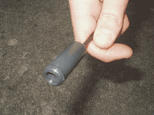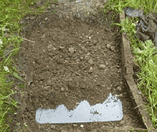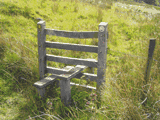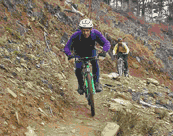 Pyro sensors react to sudden changes in ambient heat level, such as when a person's body passes in front of it. The grey tube is hidden easily in wood posts, fencing or walls - and the colour is hard for visitors to spot. It is positioned to look out horizontally at about hip height. A standard range pyro is used if the gap is relatively narrow and walkers pass within a metre of it. A longer range version is available for wider gaps. Choosing a "pinch point" where people have to walk single file will produce the most accurate visitor data.
Pyro sensors react to sudden changes in ambient heat level, such as when a person's body passes in front of it. The grey tube is hidden easily in wood posts, fencing or walls - and the colour is hard for visitors to spot. It is positioned to look out horizontally at about hip height. A standard range pyro is used if the gap is relatively narrow and walkers pass within a metre of it. A longer range version is available for wider gaps. Choosing a "pinch point" where people have to walk single file will produce the most accurate visitor data.
 Buried PVC pressure slab sensors can be used in most types of path except bedrock and thin soil. When carefully installed they are almost impossible for the public to discover. The slab is buried in a 10cm deep hole on level sand and then covered over with the original path surface material. The standard size is 50cm wide by 60cm long and 16mm thick. A smaller size suits mountain bike singletrack routes and a larger size suits wider paths where people still have to walk in single file. Several slabs can also be installed side-by-side across very wide paths so that walkers moving side-by-side are counted correctly in pairs, triples etc.
Buried PVC pressure slab sensors can be used in most types of path except bedrock and thin soil. When carefully installed they are almost impossible for the public to discover. The slab is buried in a 10cm deep hole on level sand and then covered over with the original path surface material. The standard size is 50cm wide by 60cm long and 16mm thick. A smaller size suits mountain bike singletrack routes and a larger size suits wider paths where people still have to walk in single file. Several slabs can also be installed side-by-side across very wide paths so that walkers moving side-by-side are counted correctly in pairs, triples etc.
 Stiles can be rigged with pressure sensors of various kinds. Step-over stiles can have a pressure disc concealed in between the upright leg and the horizontal tread, or a movement sensor can be linked to anti-slip expandamesh plates nailed on the tread surface. Ladder stiles can be tackled in a similar way with expandamesh nailed on every step or with a pressure sensor concealed within a laminated wooden step.
Stiles can be rigged with pressure sensors of various kinds. Step-over stiles can have a pressure disc concealed in between the upright leg and the horizontal tread, or a movement sensor can be linked to anti-slip expandamesh plates nailed on the tread surface. Ladder stiles can be tackled in a similar way with expandamesh nailed on every step or with a pressure sensor concealed within a laminated wooden step.
 Gates come in all shapes and sizes and materials. Usually each one has to be considered as a special case. It may be possible to bury a slab within a small kissing gate to get an accurate visitor count but often a magnet is used to count the number of times the gate is operated rather than the number of people going through it. Some types of gates also suit pyro sensors hidden in one of the upright posts. For some gates it may be better to utilise an adjacent path.
Gates come in all shapes and sizes and materials. Usually each one has to be considered as a special case. It may be possible to bury a slab within a small kissing gate to get an accurate visitor count but often a magnet is used to count the number of times the gate is operated rather than the number of people going through it. Some types of gates also suit pyro sensors hidden in one of the upright posts. For some gates it may be better to utilise an adjacent path.
 Car counters rely on metal detectors. Either an inductive loop is cut into the tarmac road surface itself, or a magnetometer is buried easily in the adjacent grass verge. Installing a loop is a technical job which most highways authorities licence strictly. But on private roads you can do what you like. An inductive loop is only triggered when a vehicle is directly on top of it. By contrast, a magnetometer will respond to any large iron objects moving nearby.
Car counters rely on metal detectors. Either an inductive loop is cut into the tarmac road surface itself, or a magnetometer is buried easily in the adjacent grass verge. Installing a loop is a technical job which most highways authorities licence strictly. But on private roads you can do what you like. An inductive loop is only triggered when a vehicle is directly on top of it. By contrast, a magnetometer will respond to any large iron objects moving nearby.
 Bicycles on dedicated single-track mountain bike routes can be detected with a small pressure slab under the surface provided that the track is not also used by walkers. Metal detectors, either inductive loops and magnet-ometers, are used on multi-purpose trails shared with walkers and other users. Tracks up to 2m wide with a gravel surface are best tackled with a magnetometer which will detect a bicycle a metre away all round if buried in the middle of the trail. All metal detectors must be installed so they cannot move.
Bicycles on dedicated single-track mountain bike routes can be detected with a small pressure slab under the surface provided that the track is not also used by walkers. Metal detectors, either inductive loops and magnet-ometers, are used on multi-purpose trails shared with walkers and other users. Tracks up to 2m wide with a gravel surface are best tackled with a magnetometer which will detect a bicycle a metre away all round if buried in the middle of the trail. All metal detectors must be installed so they cannot move.
